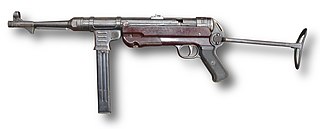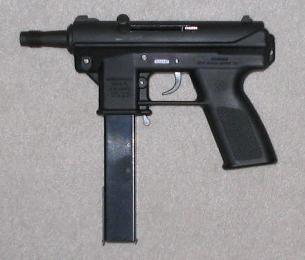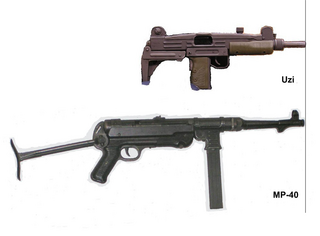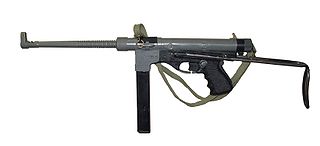
A submachine gun (SMG) is a magazine-fed automatic carbine designed to fire handgun cartridges. The term "submachine gun" was coined by John T. Thompson, the inventor of the Thompson submachine gun, to describe its design concept as an automatic firearm with notably less firepower than a machine gun. As a machine gun must fire rifle cartridges to be classified as such, submachine guns are not considered machine guns.

The MP 40 is a submachine gun chambered for the 9×19mm Parabellum cartridge. It was developed in Nazi Germany and used extensively by the Axis powers during World War II.

The Military Armament Corporation Model 10, officially abbreviated as "M10" or "M-10", and more commonly known as the MAC-10, is a compact, blowback operated machine pistol/submachine gun that was developed by Gordon Ingram in 1964. It is chambered in either .45 ACP or 9mm. A two-stage suppressor by Sionics was designed for the MAC-10, which not only abates the noise created but makes it easier to control on full automatic.
The Lanchester is a submachine gun manufactured by the Sterling Armaments Company between 1941 and 1945. It is an evolution from MP28/II and was manufactured in two versions, Mk.1 and Mk.1*; the latter was a simplified version of the original Mk.1, with no fire selector and simplified sights. It was primarily used by the Royal Navy during the Second World War, and to a lesser extent by the Royal Air Force Regiment. It was given the general designation of Lanchester after George Lanchester, who was charged with producing the weapon at the Sterling Armaments Company.
The SUB-2000 is a pistol-caliber carbine manufactured by Kel-Tec CNC Industries of Cocoa, Florida, United States. The rifle is a blowback operated, semi-automatic firearm with its operating spring located in the tubular stock.

The Intratec TEC-9, TEC-DC9, KG-99, and AB-10 are a line of blowback-operated semi-automatic pistols. They were developed by Intratec, an American subsidiary of the Swedish firearms manufacturer Interdynamic AB. Introduced in 1984, the TEC-9 is made of inexpensive molded polymers and a mixture of stamped and milled steel parts. The simple design of the gun made it easy to repair and modify. It was a commercial success, with over 250,000 being sold.
The PP-19 Bizon is a 9×18mm Makarov submachine gun developed in 1993 by the Russian company Izhmash. The Bizon was designed by a team of engineers headed by Victor Kalashnikov and including Alexei Dragunov.

A firearm is said to fire from an open bolt or open breech if, when ready to fire, the bolt and working parts are held to the rear of the receiver, with no round in the chamber. When the trigger is actuated, the bolt travels forward, feeds a cartridge from the magazine or belt into the chamber, and fires that cartridge in the same movement. Like any other self-loading design, the action is cycled by the energy released from the propellant, which sends the bolt back to the rear, compressing the mainspring in readiness for firing the next round. In an open-bolt gun firing semi-automatically, the bolt is caught and held at this point by the sear after each shot; and in automatic open-bolt fire, it's caught and held in this manner whenever the trigger is released. In contrast to this, in closed-bolt guns, the trigger and sear do not affect the movement of the bolt directly.

The FAMAE SAF is a submachine gun produced and manufactured by FAMAE since 1993.

The Jatimatic is a Finnish 9×19mm Parabellum submachine gun developed in the late 1970s and early 1980s by Jali Timari. The submachine gun made its debut in 1983. The Jatimatic was manufactured in very limited numbers initially by Tampereen Asepaja Oy of Tampere and later—Oy Golden Gun Ltd. The firearm was designed primarily for police, security forces and armored vehicle crews. It was never adopted into service by the Finnish Defence Forces, although the later GG-95 PDW version was tested by the FDF in the 1990s.
Intratec was a firearm company based in Miami, Florida. The company's most famous product was the TEC-9.

The Lusa is a compact 9×19mm Parabellum submachine gun developed by INDEP of Portugal in 1983. Its name is derived from Lusitania, which was the Roman name for the Iberian region that covers present day central and southern Portugal and part of Spain. Although it was originally intended for military use, it was well-suited for law enforcement and ended up being marketed to bodyguards, VIP protection and special operations units.

Kel-Tec CNC Industries Inc., commonly referred to as KelTec, is an American developer and manufacturer of firearms. Founded by George Kellgren in 1991 and based in Cocoa, Florida, the company has manufactured firearms since 1995, starting with semi-automatic pistols and expanding to rifles and then shotguns. Kel-Tec is a privately owned Florida corporation. George Kellgren, Kel-Tec owner and chief engineer, is a Swedish designer who also designed many earlier Husqvarna, Swedish Interdynamics AB, Intratec and Grendel brand firearms. The company has been developing and manufacturing a wide variety of firearms, ranging from semi-automatic handguns, i.e. pistols, to semi-automatic rifles and shotguns.

The ArmaLite AR-7 Explorer is a semi-automatic firearm in .22 Long Rifle caliber, developed in 1959 from the AR-5 that was adopted by the U.S. Air Force as a pilot and aircrew survival weapon. The AR-7 was adopted and modified by the Israeli Air Force as an aircrew survival weapon in the 1980s.

A telescoping bolt is a firearm bolt which telescopes over, that is, wraps around and past, the breech end of the barrel. This feature reduces the required length of a weapon such as a submachine gun significantly, and it allows compact designs to be balanced around the pistol grip in a way that gives "pointability" more like a pistol's.

The Vigneron is a submachine gun manufactured in Belgium during the 1950s. It used the 9×19mm NATO cartridge and was used by the Belgian Army until the 1980s. The Vigneron is a selective-fire weapon for short-range street and brush fighting. It remains reasonably accurate up to 100 m using sighted semi-automatic fire.

The M3 is an American .45-caliber submachine gun adopted by the U.S. Army on 12 December 1942, as the United States Submachine Gun, Cal. .45, M3. The M3 was chambered for the same .45 ACP round fired by the Thompson submachine gun, but was cheaper to mass produce and lighter, at the expense of accuracy. The M3 was commonly referred to as the "Grease Gun" or simply "the Greaser," owing to its visual similarity to the mechanic's tool.
George Kellgren is a Swedish-born firearms designer, inventor and founder of the gun manufacturer Kel-Tec. His designs include the Intratec TEC-9, Kel-Tec P-11, Kel-Tec KSG, Kel-Tec SUB-2000 carbine and Grendel P10 .380 ACP pocket pistol.
The Parinco mod. 3R is a submachine gun of Spanish origin that was designed in 1959. It is a selective-fire weapon for short-range street and brush fighting. It remains reasonably accurate up to 100 m using sighted semi-automatic fire. For close range combat, 2- or 3-shot bursts are recommended.
The SIG MPX is a gas-operated submachine gun designed and manufactured by SIG Sauer, and is primarily chambered in 9×19mm Parabellum. It is a gas-operated firearm featuring a closed, rotating bolt. These design features, rare in submachine guns, were chosen to enhance the safety of the user and to have a more reliable firearm. It was designed in 2013 and was released to the general public in 2015. It features the SIG Sauer short stroke push-rod gas system to reduce the recoil and improve the reliability of the weapon.












